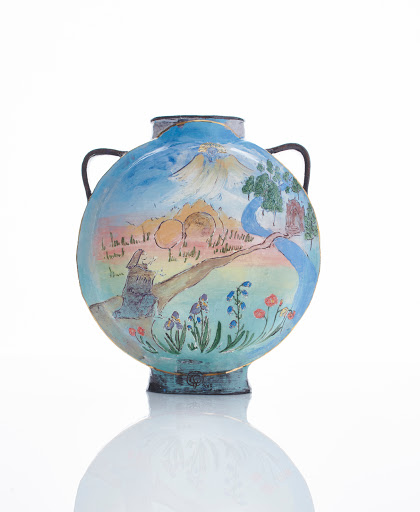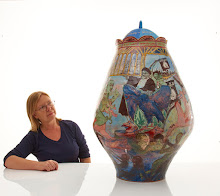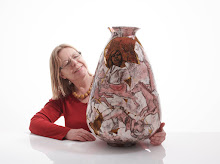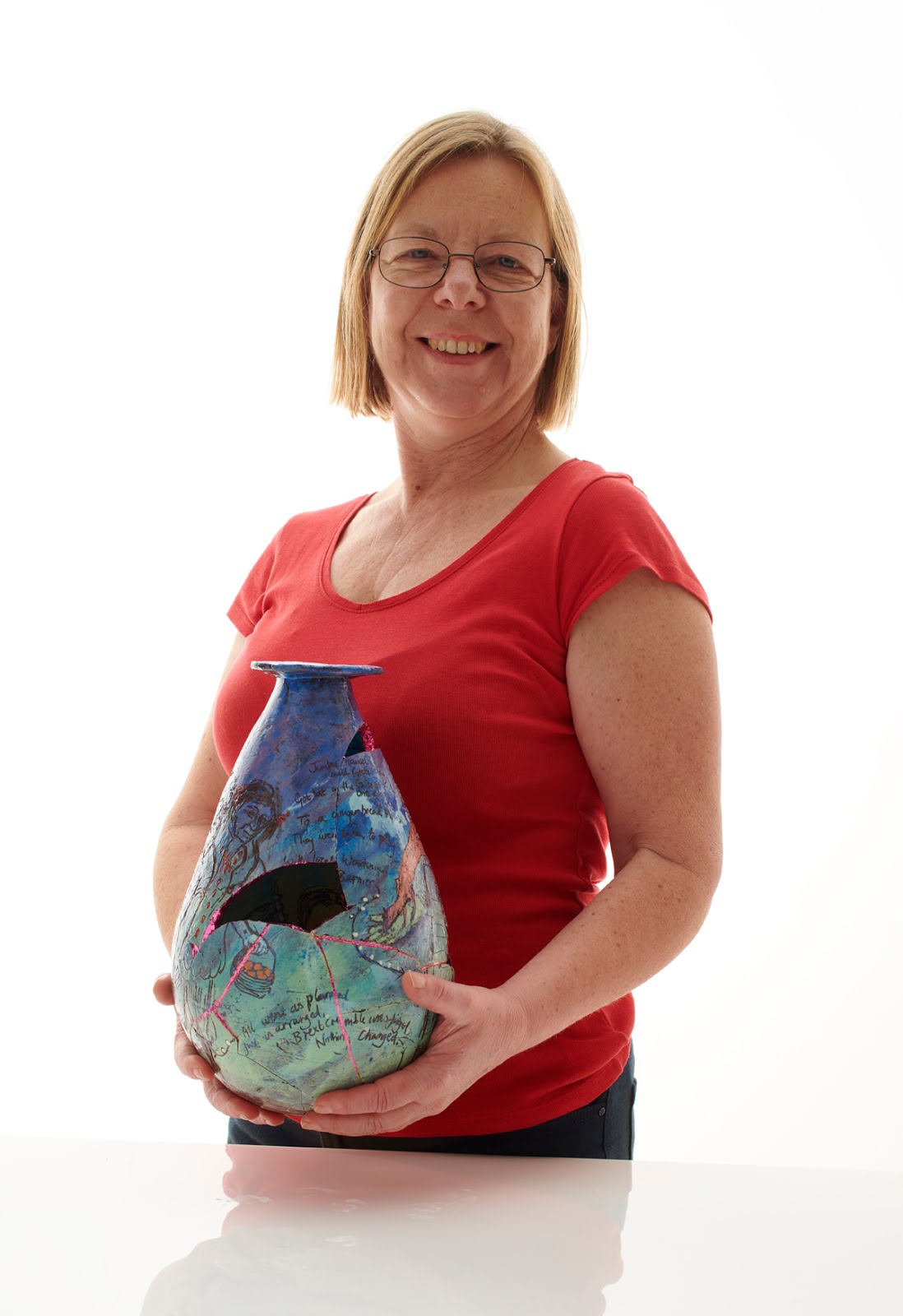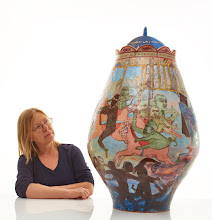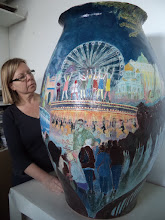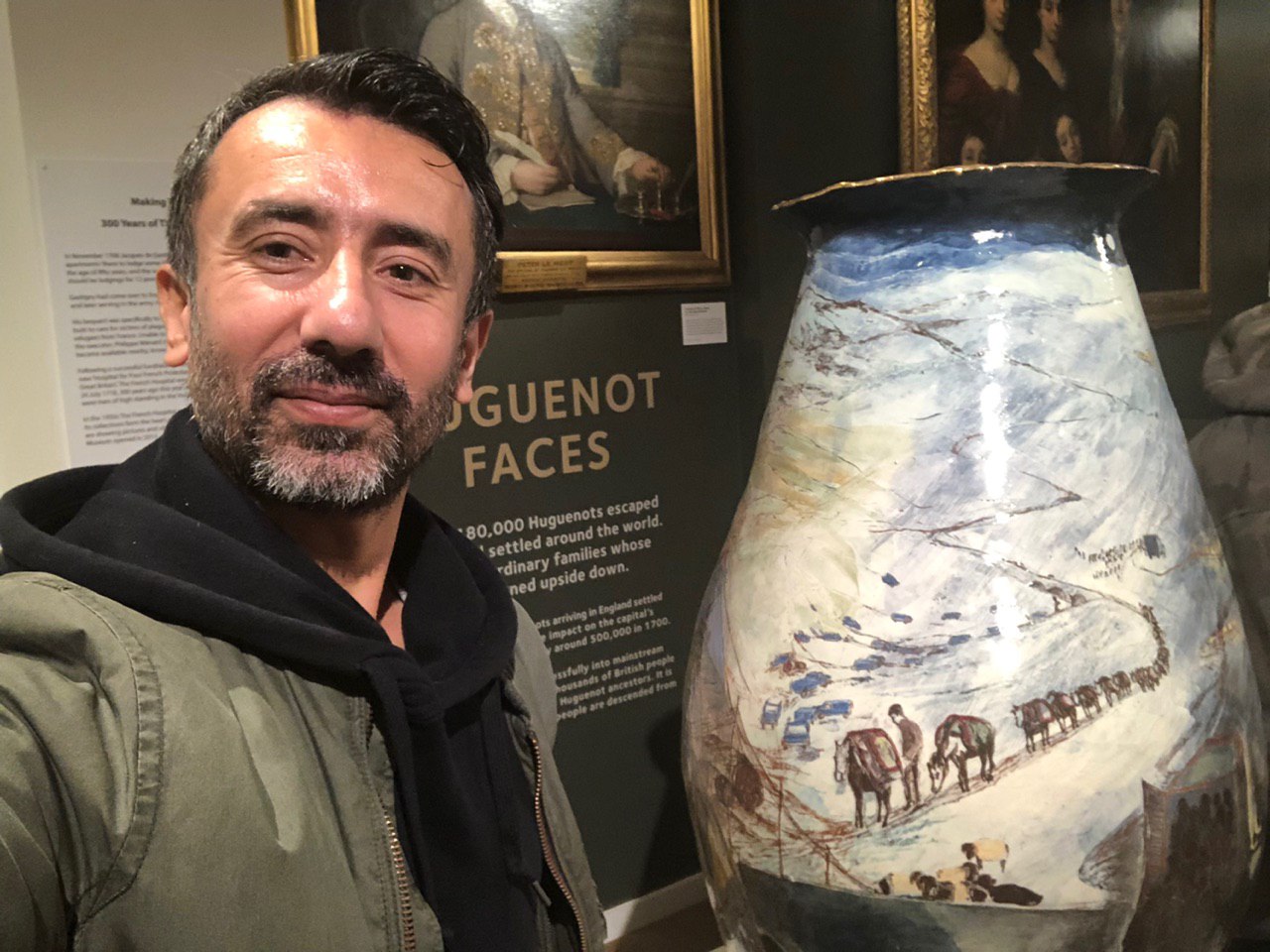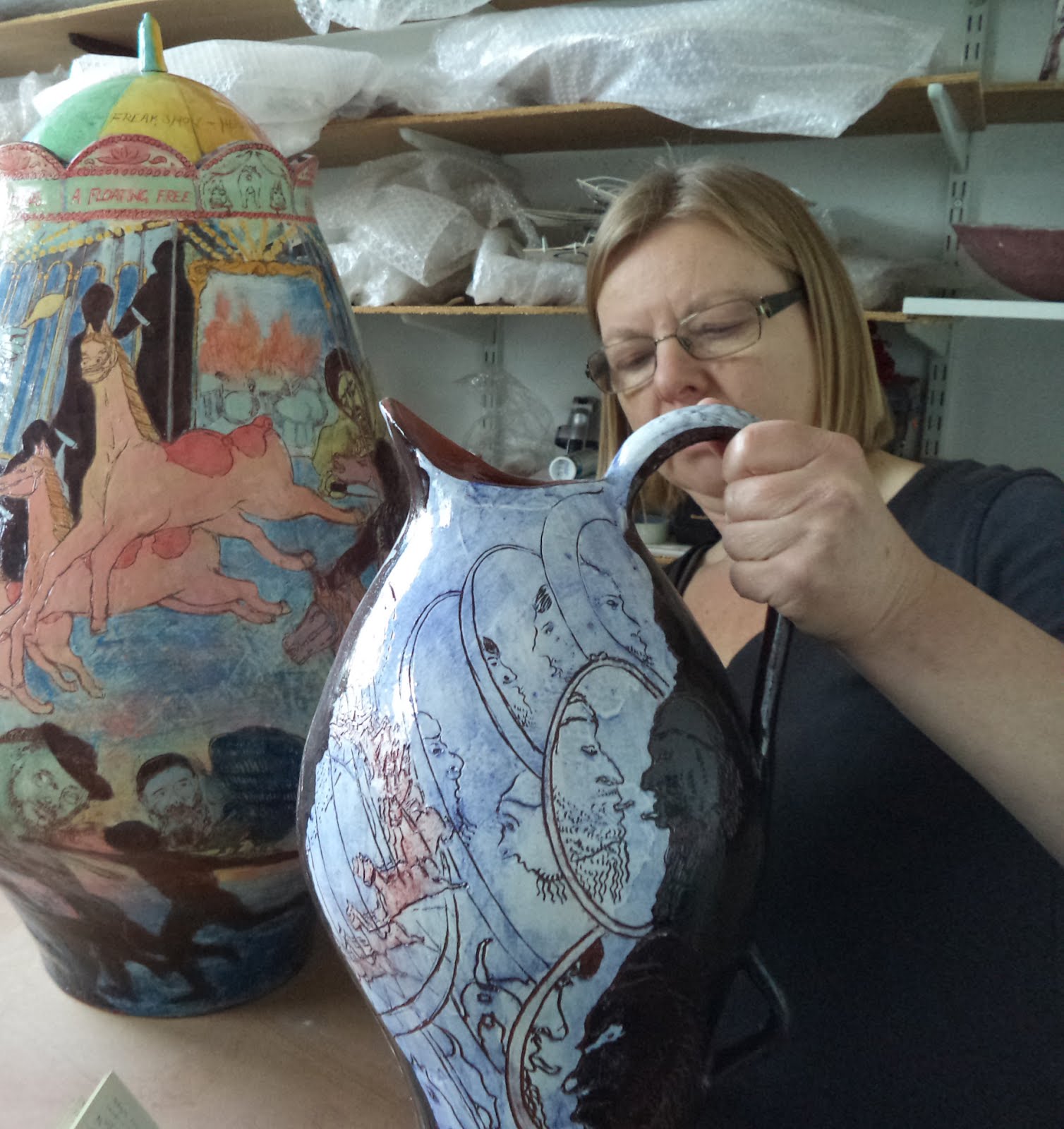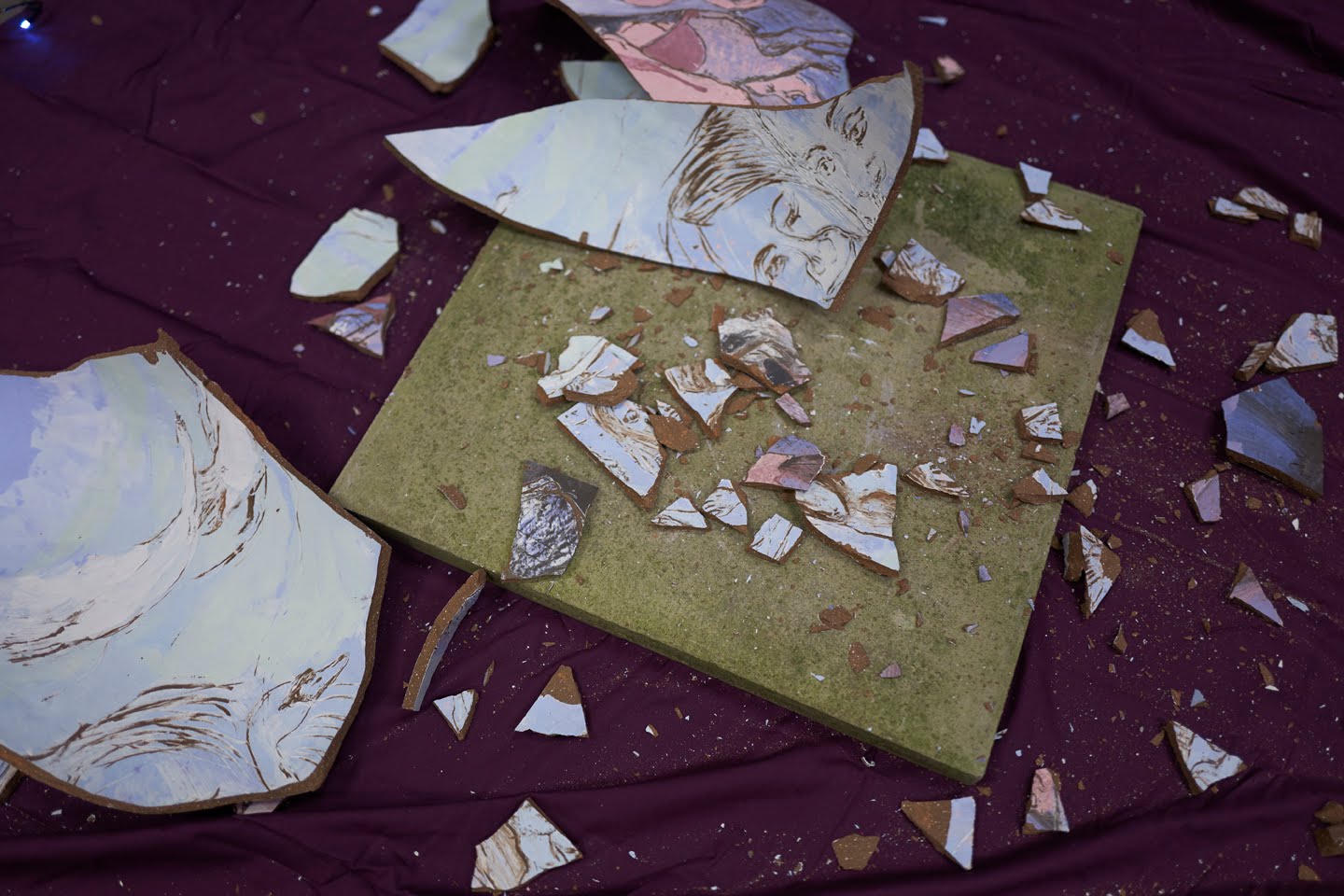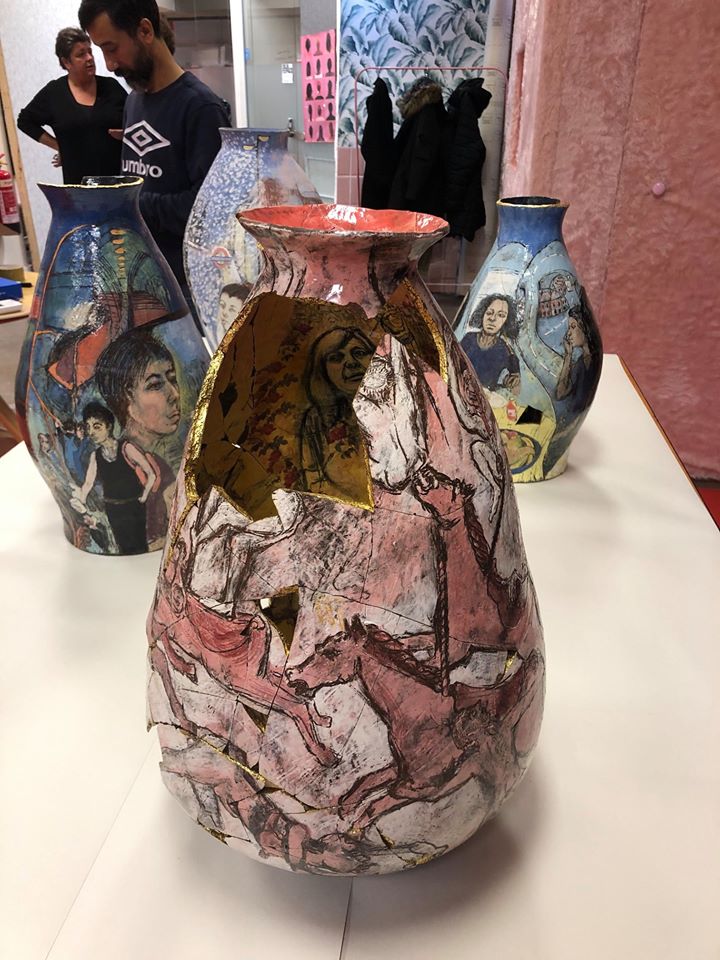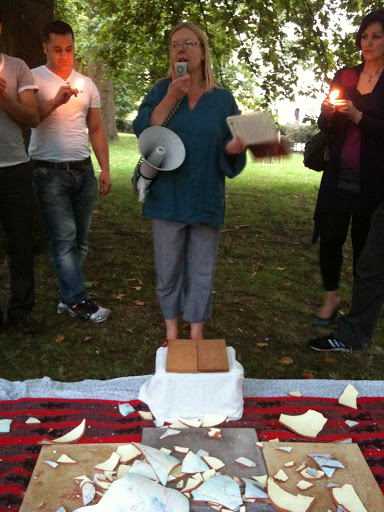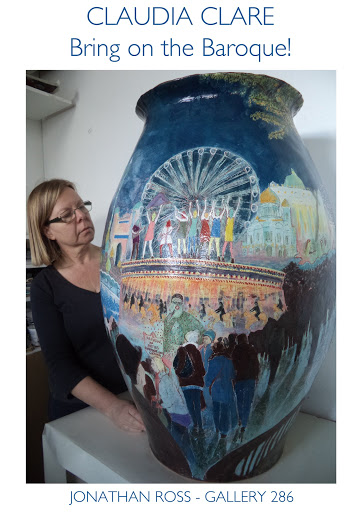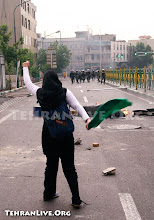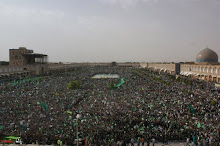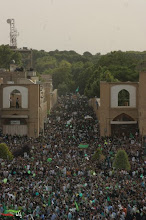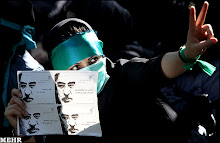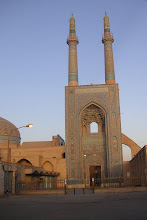Monday 14 December 2009
Some Reflections On The British Ceramic Biennial
BCB: Some Reflections On Fresh And Award Winners
I was invited to talk about this blog at a forum organised by the National Association for Higher Education in Ceramics, (NACHE). The intention, as far as I could discern, was to discuss the future of Ceramic education and NACHE’s relationship to it. The only thing I can tell you is that it looks likes it will now have some student representation and that it may well broaden out to include secondary school education. While I was there, however, I was able to have a good look at the Award Winners show and a quick look at Fresh.
The dominant theme of the AWs was undoubtedly pathos, or rather PATHOS – almost overwhelmingly so at times. It was appropriate but bizarrely inconsistent. While half of the work said, ‘I’m in mourning,’ the other half said, ‘Well I couldn’t give a monkey’s. I’m just continuing to reproduce the same stuff I’ve made for the last 30 years,’ – pots about pots and pots about material. Nothing wrong in that you might think and, indeed, there isn’t, it just looked like the selectors couldn’t decide what to do – have a show with a narrative, one which they’d forgotten to mention in advance, or choose what they fancied, mix it up and keep their fingers crossed. They probably would have got away with it if they’d had a couple more rooms to work with but, as it was, all the work was crammed into a too small space, which gave it that singularly unfortunate junk shop feel – which just added to the pathos.
The supreme winner was Neil Brownsword and deservedly so, thankfully – it always makes life easier when you find yourself agreeing with the selectors – and somewhat rare in my case – although, of course, I have no idea who else submitted images of their work, I might well have disputed the initial filter.
Brownsword chose to materialise, or rematerialise, a collection of detritus from Stoke Factories. Beautiful shreds of glazed weird bits of gubbins strewn around a plinth -the plinth was a bit unfortunate- but, as a whole, it was genuinely moving. The was a slow slide show which you couldn’t see because there was too much light, but the bits I did see had their moments- It wasn’t a slide show – it was what happens when you put the camera on a tripod and let it record whatever’s going on in front of it for a while – a series of those shot one day a week over a month or so. Some bits were shot through a wire fence which was particularly affecting.
Paul Scott also went for the pathos narrative using damaged and altered transfers on his industrially produced plates. A simple enough idea and one which communicated well.
The material-culture irony came from Connor Wilson, the ‘satire’ came from Steve Dixon who, unfortunately, decided to wrap himself in a copy of the Daily Mail, and - yes, that’s right, it’s almost too crassly embarrassing to have to write it, but he really did produce a series of pig’s heads with rosettes and little labels so we could identify exactly which politicians they were intended to represent. Moreover, he appears to have cast them from a real pig’s head which, from a distance, makes them look far too interesting to work as satire at all. Never mind. Then there was Philip Eglin – football as religion – no shit – now there’s an original idea.
We had the raku and general crustiness from David- gone- can’t remember his name, -or any of the others come to that. Ken Eastman showed that nice line in bone china, and a factory of some sort produced some SENSATIONAL paperweights, which included the campest looking owl I’ve ever seen. Fab.
Roberts – that’s his name: David Roberts. Raided his shed and brought out a couple of raku numbers he made earlier and we had those lobbed on a plinth. Oh well. Someone had to I s’pose.
Natasha Daintry produced hundreds of little – um- things- like over-sized thimbles in different colours and set them out in colour order and disorder. Looked like quite an interesting game for a particularly introspective, overly fastidious child. I quite liked it. Jacob van de Beugel was next to her with a series of thoroughly unpleasant bottles. I mean just because you’re a thrower of things unglazed doesn’t mean everything has to be brutally ugly. I think he trained with Julian Stair at one stage though. Looks like he’s absorbed all the brutalism and then turned it into multiples.
I didn’t, alas, get much sense of the architectural presentations. Sliponline have covered those and everything else in some detail with endless pictures, so best thing is to tune into them and watch the show. Then you can ignore everything I’ve said and decide for yourself.
Fresh was brilliant. Feezing cold but brilliant. It was in a disused factory workshop. I guess it’s almost inevitable that new grad shows are going to be more enjoyable than a show made up of largely very established makers because it’s not freighted with all sorts of expectations or irritations that have already been developed. Fresh, overall, had a strong sense of materiality and of the ‘place’ of ceramics in society and material culture, mainly the former though. Again, Sliponline have the pictures so that’s going to be the best place to have a good look if you didn’t get to see the show.
I’ve just remembered I missed out Halima Cassell and Clare Twomey. This is because they were easily missed. Their works were hidden, like a treasure hunt one had to stumble across them by accident. Cassell’s were perched on a ledge high above the main show and Towmey’s was hidden in gallery above the main gallery, glassed in as though it had an infectious disease – it was her jasper-ware dust again so it probably did. It’s one the best things I’ve seen her do in ages and ages. Quite creepy and theatrical. Miss Haversham may have got dressed and departed from the V&A but now we know she came to Stoke and created some kind of mayhem over the dining room table. Very literary and 18th Century – cinematic as well as theatrical.
Looking down on Cassell’s work from on high worked quite well, you really got a sense of their intricacy and also of their architectural ancestry. Her work is derived from the geometric patterns in Islamic architecture and was originally executed in brick clay – much of it, I think, still is.
Brownsword showed a film at the forum which was a sort of eulogy to an abandoned clay pit – well not quite. It was side-splitting and, from the point of the view of the film maker was clearly meant to be. Brownsword, who ‘played a starring role,’ gamely went along with it – pointing out that it was filmed like a western – but I’d say, very obviously a spoof on a western. It had that daft, hard bitten, macho pioneering-movie quality to it, the ones filmed in period costumes with endless shots of brave suffering people squelching through inhospitable landscapes in unsuitable carriages with exhausted horses, with lots of soupy music and tragic but brave moments.
My hunch is that the other two, two immensely earnest Scandinavian artists, may not have thought of what they were doing as quite so hilariously funny. They and NB were in this pit making it into a giant work of landscape art. Just watching the woman ramming her knees and jarring her spine into the not very yielding cold wet clay made me almost cry with the back pain that was coursing through me at the time. I hope I never have to watch anyone being such a bloody idiot again. Why, oh god why, do so many potters / makers think they have to act macho? I just don’t get it. As if the wholly unacknowledged derivation of Asger Jorn and Noguchi weren’t irritating enough – and let’s face it, Jorn was irritating enough to begin with.
There was much much more to see in Stoke and the first BCB was a fine tribute to that city’s achievements. I’ve said more than enough now but there is plenty more to be said. I have merely scratched the surface. I hope much more will be said and that much will be learnt to take forward to the next Biennale. There was some talk of the British Ceramics Biennale moving to other cities – perhaps – but I’d be happy for it to stay in Stoke for a while yet. It’s a weird place, but it kind of works.
Friday 11 December 2009
Some Notes From A Prolonged Absence - Getting Ready To Continue
This has been a pronged absence. I’ve been showing Shattered and nursing the most severe, vicious and unforgiving episode of sciatica I’ve ever had. It is this that has prevented me from writing. I couldn’t sit down long enough to write anything, still less concentrate on anything I might want to write.
So – how do I now squeeze everything into one small post in preparation for continuing? Well, firstly by providing two excellent links.
The first, Potkin Azarmehr’s blog, For a Democratic Secular Iran. For Peace and Prosperity in the Middle East has to be the best coverage in English of events in Iran at the moment, - so for readers interested in catching up on that check it out.
The Second is Sliponline; produced by
Eleanor Snare and Alexander Archer-Todde who are writing lucidly, comprehensively and robustly about ceramics and, in particular, have some excellent coverage of the first British Ceramics Biennale, (BCB), in Stoke on Trent.
I was going to write a post about Grayson Perry’s show at Victoria Miro, ‘The Walthamstow Tapestry,’ but pain prevented that and so too did the show itself. It just wasn’t up to his usual standard. It really lacked energy. Now this may just be a projection of mine. It was a huge effort to get there, and I’d hoped for something that’d make be glad to be alive, which his work usually does, but he seemed bored. Even the tapestry was predictable. A great idea, but the idea was better than the result, which looked like he was just going through the motions. True it’s not handmade so cant rely on the weird irregularities that occur when things are so produced, but that wasn’t the main problem – it was just too simple, nothing to surprise I suppose. Maybe this is the cost of fame – we get to know someone’s work and their way of working almost too well, so they couldn’t surprise even if they wanted to. I suspect another reason though. I think the pots were quite old and rejected in the past, just brought in for the show. I suspect that the tapestry is just a way of living up to the demands of the Perry Market. I have a hunch that the real Perry work occurred elsewhere, around the same time, at a fashion show he did at - I think it was St. Martin’s college, part of University of the Arts, London. I’d love to know what that was like because I think that’s where his spirit went. Hope so anyway. Otherwise I really will get depressed.
So – how do I now squeeze everything into one small post in preparation for continuing? Well, firstly by providing two excellent links.
The first, Potkin Azarmehr’s blog, For a Democratic Secular Iran. For Peace and Prosperity in the Middle East has to be the best coverage in English of events in Iran at the moment, - so for readers interested in catching up on that check it out.
The Second is Sliponline; produced by
Eleanor Snare and Alexander Archer-Todde who are writing lucidly, comprehensively and robustly about ceramics and, in particular, have some excellent coverage of the first British Ceramics Biennale, (BCB), in Stoke on Trent.
I was going to write a post about Grayson Perry’s show at Victoria Miro, ‘The Walthamstow Tapestry,’ but pain prevented that and so too did the show itself. It just wasn’t up to his usual standard. It really lacked energy. Now this may just be a projection of mine. It was a huge effort to get there, and I’d hoped for something that’d make be glad to be alive, which his work usually does, but he seemed bored. Even the tapestry was predictable. A great idea, but the idea was better than the result, which looked like he was just going through the motions. True it’s not handmade so cant rely on the weird irregularities that occur when things are so produced, but that wasn’t the main problem – it was just too simple, nothing to surprise I suppose. Maybe this is the cost of fame – we get to know someone’s work and their way of working almost too well, so they couldn’t surprise even if they wanted to. I suspect another reason though. I think the pots were quite old and rejected in the past, just brought in for the show. I suspect that the tapestry is just a way of living up to the demands of the Perry Market. I have a hunch that the real Perry work occurred elsewhere, around the same time, at a fashion show he did at - I think it was St. Martin’s college, part of University of the Arts, London. I’d love to know what that was like because I think that’s where his spirit went. Hope so anyway. Otherwise I really will get depressed.
Sunday 8 November 2009
November 4th / 13th Aban





‘Huh,’ snorts Masoud, ‘I’m not staying here for a load of Rafsanjani’s goats,’ and stomps off into the gloom of the early November night.
The Green Movement of London, ‘Sabz e Landan,’ formed with such verve and tenacity in response to the electoral fraud in Summer 2009, has, shall we say, hit a deciduous patch. Bits of it a tumbling off, bits being peeled back, branches we didn’t even know existed laid bare, exposed to the merciless winds of autumn, festering wounds oozing all over the place and so it goes on.
All those differences I talked about – with so much optimism- back in August, well, they’ve all risen to the surface and bubbled and spat and spouted and burst into chaotic, recriminatory rankling argument. Superficially, it’s about reformists vs. revolutionaries, but, the reformists are fighting each other as much as or more than the revolutionaries. My feeling is that this is standard issue, grass-roots-movement, jostling for power, position, visibility, clout and attention. There’s that unmistakable autumnal sound of the clunking of antlers - male antlers in this case.
I’m advised: ‘we are learning about democracy;’ ‘we have grown up in a dictatorship;’ ‘Iran has never had a democracy,’ etc. Problem is, I’ve witnessed exactly the same processes in UK grass-roots movements for as long as I can remember, and we’ve had democracy or near enough, for several centuries. Nah – these are just competitive displays of posturing, parading and intermittent punch-ups – and this is just round one. There’ll be several more bouts yet.
Meanwhile, everyone put on a brave face and behaved themselves for an evening and gathered outside the embassy on November 4th, (13th Aban – Iranian month), and got stuck into their favourite slogans and lit candles and sang and chanted and shouted some more slogans, and disapproved of each other, but it worked. For a moment I caught a glimpse of what an Iranian democracy might look like. Mottled and no mistake. The Communists were there – looking like something straight out of the British Museum, - really classy though, and they’re always so amiable and good-natured and thoroughly well behaved. The Sabz – Mousavi were out in force, which was weird because they are the ones that turn up least often. The Sabz – general-purpose-liberal-democracy-go-with-the-flow, we-don’t-really-want-an-Islamic-Republic-but-we-don’t-want-to-upset-anyone – these are the majority who come to almost all the demonstrations and who I know well, they were all there but a bit drowned out by the more pious ‘allahu akabar’ lot. And then a bunch of lefty ex-revolutionaries brought up the rear –generally in good spirits- and they too are demo regulars.
Things were very different in Iran however. The official parading of 13th Aban commemorates the storming of the American Embassy by Iranian students, so, true to recently established form, (see Qods day demonstrations, 19th September), the Iranian green protestors took to the streets in their tens of thousands in numerous cities across Iran, and called for the death of the dictator and the freeing of the political prisoners. They were beaten ferociously by Basiji for their pains but even so, the subverting of an officially sanctioned, government parade provides them with a bit more cover than they had during the days after the electoral coup d’etat. There are many more days such as these to come. I’ll try to keep posting.
My thanks as always to Iman Nabavi who takes the pictures and makes them available to all. Thanks to all who turned out to demonstrate and, above all, thanks and immense respect to the brave women and men, young and old, able-bodied and disabled who fill the streets of their cities in Iran and continue the fight for democracy against colossal and brutal odds.
Monday 12 October 2009
Miss Haversham Gets Dressed: The New Ceramics Galleries At The V&A








Edmund de Waal once commented that, ‘ceramics have not been well served by museums.’ They haven’t. Museums have tended to view ceramics as historic objects. The meaning and purpose of contemporary ceramic work, which is sometimes exhibited alongside, is at best uncertain and at worst the whole lot is confined to the top floor of the museum, like the mad woman in the attic, disconnected from the rest of the museum’s displays, with few visitors and offering no meaningful dialogue with today’s audiences.
So, the ‘mad woman in the attic,’ the jilted or abandoned bride,- namely the V&A’s ceramic collections - has had a make-over. Someone has bravely attempted to sort out and make sense of the most colossal symptom of inflated imperial over-production imaginable. The V&A seems to have examples of everything ceramic that has ever been made or collected.
I am one of those few visitors that used to climb to the top of the museum, with flask and sandwiches and compass in case of bad weather, and spend hours gazing at rose-painted Chinese enamelware, and decorous Sevres porcelain. I’d stop, about half way up to adore the stoves, which had somehow escaped. I seem to remember them being on the next floor down, but I’m probably wrong.
The main thing is that it’s all still there – acres of it in new cabinets. Yes, it’s still all in cabinets. They haven’t gone that radical. Much of it is still crowded like Kings Cross on a rainy Friday. But you can still warm yourself on the stoves and gaze with love at the Andrea della Robbia leaning nonchalantly against a wall somewhere.
Pots At Work: Teaching Ceramics
The really BIG change is the teaching gallery. It has a real live studio where you can watch real live potters making things, like going to the zoo, only I don’t suppose mating in public is encouraged. There’s a reconstruction of a Lucie Rie studio – now this is interesting because the ‘studio potter’ is presented as an historical exhibit – so this must be the stuffed extinct animals section of the museum. The middle bit of this gallery, like a spine running down the centre, is a display of clays and glazes and all manner of ‘how to do it’ explanations and instructions. It’s brilliant. The best bit of the whole show is in this section. It’s called ‘under the sea’ (something like that). It’s a case full crockery that has been salvaged from wrecked ships that were carrying tea and the like from ‘The East’ and also carried chests full of crockery. It’s got bits of coral and you can almost smell the salt water and see the fish. It’s wonderful.
Contemporary Collection: The Ready-Mades
Finally – the other big change – is the attempt to exhibit the contemporary collection and connect it to the historic collections. Where they’ve mixed it up with the historic collections, it really works well. The teaching section has a several cases of contemporary work –mostly from Norway with a couple of particularly successful pieces by Paul Scott, (UK). These are examples of works where the artists are using ‘ready-mades,’ and they undoubtedly fare best in the V&A context. The overwhelming majority of the collections are made industrially - that’s just what people like to collect. So inevitably the work that is connected with the ceramics industry is in the right context. At last! These makers have not, in the main, been served that well by craft galleries.
Contemporary Collection: The Clay Pots
There ‘s also a collection of industrial based work in a cabinet in the ‘Contemporary Ceramics’ section and, again, you immediately sense it’s in the right place. The rest of the work still struggles for some reason. Ten years ago, someone asked me to go and look at the V&A contemporary ceramics collection and tell them what I thought of it. I said I thought it was an absolute disgrace. I remember being really horrified. It was an apology for a collection. Not only was it shockingly narrow, restricted to the worst kind of stoneware ‘Camberwell-Grey’ studio ‘vessels,’ it didn’t even have the best examples of those. It resembled the reject section of Oxfam – the stuff they put in boxes on the pavement and sell for a quid. It’s not quite as bad now. Modernist stoneware has expanded to the next phase of modernism, but it’s all still strangely soulless. From dirty modernism we’ve progressed to clean shiney modernism. They are now buying better examples of people’s work and certainly the industrial collaborations and readymade users are looking good – these kind of artists just make much more sense of the obsession with being clean, shiny and meticulous.
Signs and Wonders: Edmund De Waal, 2009 - He started this post so I’ll let him end it
Structure
The new, improved contemporary collection is displayed in a dark and solemn room like a tomb. It’s not a room as such, it is a wooden gallery - In the middle is a square opening. You can peer over the balustrade down into the entrance hall. The big lumpen mounds of fired clay which represent the truth-to-materials section of the contemporary work is arranged on a semi circular raised runway which embraces the gallery. The semi circle of the ‘stage’ – for such it is – the pots are spot lit in a brave effort to make them look more dramatic - connects it to the dome above. The bright white of the dome is circled at its base by a glistening red steel bracket. If you were to take a cross section of the bracket it would look like one of those square brackets: ] - like that. On the lower lip of the bracket are perched the white pots you probably associate with Edmund de Waal. The overall effect is slightly more elegant-interior-design-ish than I was expecting. I had imagined something that would look immensely precarious and a bit dangerous, with the pots stacked up to some height. It’s actually much more controlled than that, more arranged. The colour is magnificent. It really lifts the drowsy darkness lurking below – there is a lightness about the work, both in the sense that it is well lit and in the weightlessness sense, that provides a sharp and very welcome contrast to the layer beneath – where one half expects some of the crustier pots to start hatching.
What It Feels Like
The best bit is remembering to check from the entrance hall downstairs on your way out. You really can see it from the ground floor. From there it resembles the gums of some frightful hag bearing her chipped teeth at you. When you get closer, the chipped teeth turn out to be pots. They contain elements of various part of the collection so it is like a celestial meditation on the mighty imperial collection of collections.
Congress
One of the aims of Signs and Wonders was to connect the historic and contemporary collections and to embed it all in the architecture of the building. This it does very successfully, especially since it also connects the two, apparently disparate halves of the contemporary collection – the ready-mades and the carefully made, finely produced porcelain appear to have no connection whatever with the big beasts in the darkened cave. If you were to view it Marxist terms, it would be like trying to connect the lumpen proletariat – noble peasants toiling in the cave, with the petty, ever-so-refined bourgeoisie nestling in cabinets with tight lips. De Waal’s pots occupy the space which is exactly in between and which is somewhat under occupied at the moment. He still makes pots. They’re clay pots. They’re not obsessively clean and finicky and tidied up to within an inch of their lives – at least thy don’t look like they are – and porcelain seems to attract the most anally retentive of potters who just cant resist imitating the precision of industrial ware. De Waal relishes the wonky aspects of the material, its ‘mind of its own’ness, he certainly doesn’t do precious – well a bit sometimes, but not so it makes you worry, but not does he pretend he’s toiling in the mud. De Waal’s ‘collection’ is more like a conference of pots and they do succeed in unifying the two halves which is quite a feat.
Wednesday 7 October 2009
Origin, The London Craft Fair, 2009




I didn’t expect to be assailed by the scent of lavender when I got to Origin, but I was – well it is a craft show after all - and a nice lady called Maxine Sutton has very obligingly, understood what craft is really about and made lavender bags and tea cosies, handsomely printed and sewn up like children’s sewing kits. They really are the business and the best bit is that the lavender bags have biologically in/accurate hearts printed on them. The heart design is the sort that shows valves and arteries but the shapes are traced in leaves in flowers. Brilliant!!
So Origin begins with a hint of the village flower show while being, unmistakably, a glitzy urban trade fair – a bit kitsch, a bit snazzy, a bit – well very naff at times – but proud. This is what works so well with this year’s selection, it seems much more certain of its own identity, much more confident than it has in the past. Industry is present but not dominant, it’s part of the process in conversation with the handmade or individually designed. This year’s ‘interventions’ use the ancient uber-craft discipline of basket weaving, - but this is post-modern basket-weaving, forget physiotherapy. I’ll write more about them next week, once they’ve had time to develop. Gone are the dark recesses containing ‘art’ as though it was something mildly unpleasant deposited under a lamp post. Origin, in short, has ‘come out.’
Jewellery, textiles of various sorts and ceramics dominate. There is a strong flavour of pink, lacy, girly feminine, - it’s a bit in yer face at times, splendidly tasteless, but a VERY welcome relief from the tedious thudding masculinity of ‘pure’ studio craft. Origin is altogether more promiscuous than it was: round the corner from the lavender you know there’ll be a bit of expensive cheap perfume. Someone made jewellery that looked like chocolates and presented then in pink sponge like fairy cakes. Ludicrous but very very effective.
Consistent with the extravagant cavorting of ceramics the other side of London, (in the Temple of the Applied Arts,) Sevres porcelain was a strong flavour in this year’s ceramics selection. Excessive, absurd, I’m not sure I really want to see it again, but it was fab just this once. See Kate McBride, Timea Sido,(second picture from top), and Jo Davies, for instance. At the extreme end of this is Jasmine Rowlandson – the Donatella Versace of UK ceramics. It looked tailor made for the Dubai market to me, but should do well here is she can reach the various diasporas to whom it will undoubtedly appeal.
This is not to say that ‘old fashioned’ studio ceramics has turned tail and fled. All of the above is ‘old fashioned studio ceramics.’ But somehow there’s more ceramic and less studio – its less noble peasant and bit more whorish – halleluja. A nice bit of anagama firing or similar would have provided a good contrast, but that kind of approach to making was conspicuous by its absence. It’s a relief not to see grizzly stoneware, but the swathes of pink gold and frills will pall very soon if its not balanced out with something a wee bit calmer. You cant live on marshmallows alone.
Chris Keenan, The Guardian Angel of Celadon Coated Tableware was there, representing ‘proper pottery,’ and also proving that celadon can still be tableware, it doesn’t have to be deconstructed to be desirable. Sue Nemeth’s Middle-European, folk-pottery inspired mould-cast porcelain, (picture top), brought all the strands together - very proper pottery, while also very pretty, feminine without being fetishistic, graceful, and very much her own vision.
Week one was seething with visitors within the first few hours of opening. That morning, Deborah Carre of Carreducker had received a Selvedge award. Now the presence of these shoemakers is something of a triumph. It’s a been a long time coming, The crafts Council, for decades, would have nothing to do with them. Not ‘pure’ enough apparently. But they, the CC, have now embraced design and collaborations with industry, so, with a bit persuasion from various people no doubt, shoemakers are at last allowed in. Carre’s stall looked magnificent. She had a case showing the tools of the trade as well as collections of beautiful hand made shoes. It was the proof positive of the confident, trade fair approach, a convincing exposition of craft as an industry in itself.
Belly Dance Congress, September 2009

Middle Eastern dance, popularly known as ‘bellydancing’ suffers from all manner of image problems in the West. Firstly, ‘Middle Eastern dance,’ as such, doesn’t exist. There are hundreds of different kinds of dance and, although you will hear people speak of ‘Turkish’ dance, ‘Egyptian’ dance and so forth, it should be understood that these various ways of dancing are really more associated with regions than national borders and even more strongly associated with culture - culture shaped by communities – by their language, religions, occupation, history and relative mobility.
Dance Migration
The extent to which various population groups have migrated, and also the extent to which they themselves have acquired new populations and influences, has had as great an impact on dance as it has had on language, religion, cooking and all other forms of social and political discourse. Thus the traditional, folkloric dance of the Egyptian Camel herders of the Nile region, ‘Saidi,’ for example, will be categorically different from the ‘Mwahashat,’ an Arab/Andalucian court dance. Technically though, they’re both Middle Eastern dances or ‘bellydancing.’ To add to the confusion, they may share some characteristics depending upon exactly which Arab population it was which colonised the Andalucian region of Spain and when.
Restaurants and Cabaret
Bellydancing, in the West, is often considered to be an embarrassing episode in dodgy restaurant at best and, at worst, a form of strip tease. It certainly counts as ‘cavorting in an unseemly manner in public,’ whichever way you look at it and it’s almost always considered to be amateur. So professional dancers in this discipline have their work cut out. Not only do they have to dance better than anyone else if they’re going to have a ghost of chance of being taken seriously and getting paid for what they do, they also have to ward off the prurient interest, entice those with a genuine interest in dance and then, after all that, create opportunities to perform. That bellydance has never, to my knowledge, received any public funding, also speaks volumes, especially when compared with other kinds contemporary dance.
Orientalism and Authenticity
Further complications are added by those who consider the whole business to be an exercise in post imperial Orientalism of the most insidious kind. True this would have to come from someone largely ignorant of the history and culture of the dance and somewhat naïve politically but it shows what serious exponents of this dance are dealing with. If it's 'authenticity' you're looking for, you may need to look elsewhere - if not, take a look at the last video on this post featuring Fifi Abdo dancing at a wedding surrounded by christmas decorations in Egypt. If that doesn't disrupt every last vestige of concern with the 'A' word, nothing will.
From Hollywood to Hip Hop
In the 20th Century, Cinema, especially Hollywood had a huge influence on the Urban dancers of Cairo and Cairo duly returned the favour to Hollywood and particularly to 1970s American pop. Ballet seems to creep in all over the place and I have no doubt that Hip Hop is mixing it up a storm with Saidi and a tinge of Flamenco somewhere – London probably – or Surrey – that beating pulse of the Bellydance Universe - Oh yes! For it was in deepest, darkest Surry that we convened in sequinned apparel to shimmy, camel and undulate our way through three glorious days of sunshine and dancing.
What Happens at a Belly Dance Congress
Bellydance Congress sets aside all these anxieties, raises the calibre to the heavens, and summons the assembled deities of the dance to come and show us the real thing in all its variety and complexity. Congress brings in the megastars from all over the world and devoted fans and students who came from as far afield as the USA and Russia to attend master classes, workshops, and take a once in a lifetime opportunity to see some of these people perform.
Classes and Stars: Leyla Jouvana
I attended two three-hour classes with Leyla Jouvana, one on layering of techniques and moves and the other on dancing with two or more veils to a mixed ability class. I did a technique class, also three hours, with Caroline Affifi, a tabla solos class – that’s dancing to a solo drum - with Kay Taylor and I had the exceptionally good fortune to be facilitating a class with Randa Kamel. In principle I was facilitating one of Leyla Jouvana’s classes as well, but she did not teach in a way that required it so I was able to do the class in full. Jouvana (Germany) and Kamel (Egypt), are major stars and rarely in this country so the opportunity to do their classes is a rare, extraordinary and invaluable privilege. Jouvana’s rigour and attention to detail accompanied by careful, precise explanations make her an exceptional teacher. She is accompanied by her husband, Roland, on the drum, so the music is always exactly as she needs it.
Randa Kamel
Kamel’s class, the one that I facilitated, was for dancers in grades 3 and 4 and I know from experience that these grades at international level are much higher than is appropriate for my experience. ‘Facilitating’ in this instance means that I had to ensure that the rows of dancers in her class were rotated regularly so that everyone had a chance to be at the front. Even now, remembering being at the front of her class, so close to her that I could see clearly every move that she made and exactly how she did it, brings tears to my eyes, it’s a chance I don’t really expect to be repeated and I shall not forget it soon. Hers was not an easy class to follow and many of the students clearly struggled in spite of my best endeavours to ensure they could all see, but the truth is, many were just not up to the level she expected of them.
The Mighty Fifi Abdo
This year’s Bellydance Congress was dominated by the legendry presence of her Imperial Highness, (massive drum roll), her Royal Magnificence, the Astounding FIFI ABDOOOOOOOOOUUUUUUUUUUUUU!!!!!!!!!!!!!!!!!
Gasp. Now I get it. Now I understand why everyone talks of this woman. I talked at length in this post about the problems that Bellydance faces in the West. One of the results of this is that we now have a collection of dancers, excellent dancers, who produce highly polished performances, virtuoso displays of technical perfection. And, yes, they make you gasp, but after a while of seeing one after another after another of these displays, one can start to lose the will to live. The intense focus on technique really can be a bit soulless and where you have a dance whose exponents often rely on cabaret to build up experience, it seems we lack a demanding dramatic repetoire that might serve as a training ground for evolving performance dancers.
The Horse, The Hurricane and a Touch of the Divine
Fifi Abdou whirls through all this like a hurricane. Her dance has a kind of roughness and raw edge to it which is wholly unexpected. She struts about on stage like she owns not only the stage but the audience too. She tosses her mane like some demented dervish horse and twirls and shimmies simultaneously punctuated by deep bowing twirly things – we call them ‘breaks.’ No one dances like this without close attention to detail and careful learning in the early years, but technique, practice and training alone will not bring it either. She’s an immensely expressive, intimate dancer, bold and brash in her gestures, there’s almost a touch of aggression, but combined with her own unique equine grace it all results in an electrifying stage presence and performance.
East & West: Cross-Cultural Encounters - The Conference

View of ST. Andrew's looking out over the harbour
I’ve always been a bit suspicious of Art History. When I was still at school and also when I went to Art School and the early 1980s, Art History was about the lives of painters and about ‘brush strokes.’ ‘The Renaissance,’ meaning the one that took place in Western Europe, was deemed to be centred in Italy, specifically Florence; this Renaissance was the back-bone of the subject. All other parts of the History of Art were somehow attached to or related to this time, place and collection of work. I still love Florence and I love what I learned of that time, but I’m very happy indeed that History of Art has become something else entirely, as East &West: Cross-Cultural Encounters eloquently demonstrated.
Orientalist Painting In Poland
The papers in this conference took me into corners of the history of the art that I didn’t know existed. I had no idea, for example, that Polish artists in the 19th Century were producing Orientalism in paintings every bit as rhetorical and absurd as anywhere in France or Britain. However, the underlying narrative, according to Ana Chruscinska, was predicated on Poland’s political situation, particularly its loss of independence, which prompted artists at that time to deploy the Orientalist imagery as a metaphor to describe Poland’s own subjugation.

Ana Chruscinska: Myths about the inhabitants of the Arab World as depticted in 19th Century Polish Oriental paintings
Hungarian Ottoman Woodcuts And Mock Battles
Also examining a nuanced relationship to imperialism and its imagery, AnnMarie Perl discussed the relationship between Hungarian and Ottoman artists during the Ottoman period when Hungary formed part of that vast empire. Far from being divided along cultural and ethnic lines, she argued that there was a well developed cross-cultural transfer which substantially unsettled the idea of an ‘authentic’ Ottoman aesthetic and genre. All this was discussed through book illustrations – wood cuts - and mock battles – yes Mock Battles –the Reenactment Society is not, after all, one of the more outré and eccentric inventions of Middle England, but was a major source of entertainment in the Ottoman Empire and documented in woodcut illustrations. Marvellous!
This, I discovered, was what I loved about Art History. It’s the weird little details which seep through and which tell you so much about the period. I was envisaging Hungarian and Turkish or Armenian or Greek artists dining together in each others houses and swapping tabards and swords before gadding off the local tea house to get uproariously drunk and party it up a storm in the street staging a mock battles till dawn when they’d be rounded up by the district gendarme for being drunk and disorderly and sent home to sober up.

Dr. Seung Jung Kim: The Beginnings of the East-West Dialogue: An Examination of Dionysiac Representations in Gahdhara and Kushan-Mathuran Art
Original Copies
Authenticity, as you might expect, was a dominant theme of the conference and it waltzed into view with Princess Akiko’s paper on the gentle art of reproduction. Her focus was on the repros of Japanese artefacts in the British Museum. Konstanze Knittler talked about ‘Famille Noire’ - a very weird-looking kind of porcelain that I’d never heard of – with a very intriguing story attached. It seems that hundreds of wealthy collectors have collected thousands of pieces of black porcelain believing them to belong to a much appreciated part of Chinese porcelain history – the Kanxi period, (1622-1722), and that this ‘famille’ turns out to be the bastard progeny of another period entirely – late 19th Century – Perish the thought!! This, along with Princess Akiko’s paper, neatly encapsulates much of what the conference discussed, namely, who’s to say what’s authentic and what if the reproduction is really more interesting than the ‘original’ ?

Dr. Claudia Clare: The Artist and the Coup D'Etat: A User's Guide to Exhibiting Ceramics in Politically Unstable Situations
Seen Through The Lens
The lens – the fiendish camera – popped up every so often. It began the conference and ended it – in a way – and it appeared in the middle cleverly disguised as paintings by Jackson Pollock. This was about a group of Japanese artists - the Gutai group, based in Osaka in the 1950s. They are widely thought to be influenced - almost formed really – by Jackson Pollock and that their work sprang out of and responded to his as an homage. However Natalie Roncone’s paper showed that what they were responding to was not Pollock’s painting or his writing but to a collection of photographs by Hans Namuth of Pollock ‘in action,’ published in a 1951 issue of ‘Art News.’ In other words their ‘homage’ was predicated on someone else’s interpretation and mediation of Pollock’s work.

Dr. Luke Gartlan: Portraying China's 'Character': Baron von Stillfried's Portfolio of Shanghai Photographs
Confusing The Image
This first appearance of the camera was in the Keynote speech by Dr. Luke Gartlan, about a collection of 19th Century photographs of ‘life’ in China which failed to attract buyers and was quickly abandoned. Gartlan argued that the main reason for this was that this album of, let us say, ‘images of China’ did not meet or in any way match the image of that country that the Western consumer expected. He compared it to similar albums made by the same photographer, Baron von Stills, of Japan which sold in their thousands. They look remarkably similar. And that’s the rub. They weren’t supposed to. China was considered an, ‘unpaved, dirty, stinking,’ place, quite different from the elegant, stylish exotic Japan. The Western Consumer duly turned up its western nose and refused the offering.

Shirley Bahar: A War Within: The Westernized Performance of Israeli Artists
Had We But World Enough And Time…
This is such a tiny bite of what was really a feast of careful, passionate research and lovingly honed knowledge. There were papers on consumers of Manga, on queer masculinity and nationalism, (possibly), in Japanese / (American?) photography, on masculine self reflexivity in Israeli film, on 18th Century Chinese court paintings, on Graeco-Roman representations in Kushan Buddhist art, on contemporary Chinese calligraphy, on Orientalist bookcovers in contemporary Western publishing, and on a kiln maker and designer of production methods in the Leach pottery, by name of Matsubayashi Tsurunosuke, who’s immense contribution to that pottery and, by implication, to British studio pottery, has been largely written out of the history. All of this was served up with delicious food, sunshine and a fabulous beach in one of the most beautiful towns I’ve seen in years. My thanks to the organisers, to my fellow participants, and to Ana Chruscinska and, (again), the conference organisers, who made the final lens-based contributions by providing all of the photographs on this post.

Dr. Shinya Maezaki: A Legacy of Matsubayashi Tsurunosuke in St. Ives: Introduction of the Art of Japanese Ceramic Making to British Studio Pottery
East & West: Cross-Cultural Encounters, Introduction

School of Art History, St. Andrews University, 11th and 12th September, 2009.
The Railway Station In A Field
On the East cost of Scotland, sort of southernish by Scottish standards, there’s platform in the middle of a field with a metal bridge slung a bit carelessly over the top of it. That’s how you get from the train, which just about remembers to stop for a minute or two by the platform, to the road. Otherwise you’d just tumble straight into the field. This windswept, lonesome, soulful looking place, something between Edward Hopper and Andrew Wyeth, is Leuchars. It’s where you get off to go to St. Andrews.
St. Andrews - The Town
St. Andrews, just five miles or so down the road couldn’t be more different. Home to one of the oldest universities in the world, - founded in 1413 – it is busy, thriving, wealthy beyond its modest size, and astounding beautiful. The town is the university and the university is the town. Shops, restaurants and hotels rely on the busy-ness of academia and on the achingly beautiful coastal landscape for their incomes - its other industry is tourism, especially tourism related to golf.
Chance Encounter
So, imagine my surprise, when stepping carefully off the train in Leuchars, and looking around at my fellow travellers, I spot a woman who, I decide, must also be coming to the conference, and accordingly invite her to share a taxi. ‘What’s your name?’ ‘Forough’ she says. ‘Crikey,’ I’m thinking, ‘what are the chances of that?’ I spend all summer in London in the company of Iranians, I come to a very very small town in the east coast of Scotland, whose railway station is 10 miles away in the middle of a field, and the first person I meet is Iranian.
Dont Forget To Switch Off The Lights
Later that same day, I venture into town to the beating heart of the university, and find the New Arts Building where I plan to register for the conference. Almost every name on the conference list is Iranian. ‘What the hell’s going on? Is there anyone left in Iran?’ Then I read the title to the conference programme, ‘Historiography and Iran in Comparative Perspective.’ Ok, so I’m about to gate crash someone else’s conference. But seriously, is there anyone left in Iran? – they all seem to be in Scotland.

Filed Under History
But you see, it’s not so surprising. St. Andrews and its quaint medieval Scottish streets is also home to the Institute for Iranian Studies. It’s cunningly hidden in the History department, not, as I thought, in The School of International Relations – although there you will find the intriguing Centre for Syrian Studies. I have to say, a bit of Syria and a bit of Iran, a chunk of unusually interesting Art History mixed up with bits of Armenia, Georgia, The Caucasus – all based in Scotland, near Edinburgh, but in St. Andrews, sounds like my idea of Heaven. Surely I could squeeze myself in somewhere…

Saturday 3 October 2009
The Street Protests Continue
September the 18th, Qods Day, September 28th, Back to Uni and Any Other Day, the protests continue. Below are three film clips. Two are from Qods Day, the first shows two separate marches in two main roads in Tehran, on the left is the green movement rally, on the right is the government rally, the latter is sparsely attended compared to the the former. The second is a short clip of a qods day march in slow motion which is easier to look at than some of the more frenetic phone-filmed clips in the post below.
The third film shows an argument in the Tehran Tube. The young women in the foreground and some of the others on the tube are shouting slogans that compare the behaviour of the Basij, the pro -government militia group who are always dressed black and ride motorbikes, to that of Israeli soldiers in Palestine. The man shouting 'death to Israel / marg ba Israel' is becoming increasingly isolated. He appears to be only one calling this government approved slogan by the end of the clip.
The third film shows an argument in the Tehran Tube. The young women in the foreground and some of the others on the tube are shouting slogans that compare the behaviour of the Basij, the pro -government militia group who are always dressed black and ride motorbikes, to that of Israeli soldiers in Palestine. The man shouting 'death to Israel / marg ba Israel' is becoming increasingly isolated. He appears to be only one calling this government approved slogan by the end of the clip.
Tuesday 29 September 2009
Qods Day, September 18th 2009, UN meeting New York, September 24th 2009 and Back to Uni, 27th September 2009.

It seems important to provide some update on the Qods day protests in Iran and, if I can find pictures, on the protests here and especially in the US on the 24th September, when Ahmadinejaad addressed the United Nations in New York.
The press coverage here in the UK of events across Iran on Qods day was truly deplorable. Not because it was misrepresented as such, but because it was studiously ignored – another kind of misrepresentation.
Facetious remarks aside – what the hell is Qods Day?
Qods day is also called, ‘Jerusalem Day.’ Originally, it was intended as a day of support for Palestinians and for autonomy, liberation and self-determination for the people of that profoundly oppressed, beleaguered and abused nation. Long ago, however, that was forgotten. In Iran, since the dawn of the Islamic Republic, it has been used for the self-aggrandisement of the ruling theocratic regime which relies on the brutalisation of Palestine by Israel to justify its own existence.
Where Were The Press?
The wholesale debunking of Qods day by the people of Iran, from all classes, all age groups and all over the country is a matter of immense, incalculable significance. Why the BBC ignored it and, as far as I’m aware, all other British news channels and organisations, both print and broadcast too, is beyond comprehension. It is true we have no journalists there. It is also true that once ‘the moment’ has passed, news deadlines and the ‘sexiness’ of a story is deemed to have evaporated. Jim Muir in Lebanon said he hadn’t heard anything much, ‘certainly nothing like the mass demonstrations we saw earlier in the Summer.’ Ok, so he’s an Arabic speaker not a Farsi speaker and I’m not persuaded that he was ever really very interested in Iran even when he was there. John Lyne, the current correspondent, always sounded bored rigid and baffled by every aspect of Iran, until it all got a bit exciting which awakened his interest but, because he appears to have so little background knowledge and so little real interest, it is hard to sustain. It seems to me that the absence of any real analysis of this event, - which was absolutely momentous – was, for most part, owing to incompetence – an unedifying mix of ignorance, clumsiness and lack of interest.
What Happened?
Qods day in Tehran, Shiraaz and Esfahan saw the people of Iran turn out in their thousands, except in Tehran, where they numbered somewhere around two million – yes you did read that right – 2 million. As a strategic move, it was a stroke of genius. The opposition movement, the ‘green’ movement, used the Qods day marches as a cover for demonstrations all over Iran. Qods day in a national holiday and it is expected that all good Muslims, aka all good Iranians will march. For years it has been ignored by many with numbers dwindling. Not so this year. The people en masse took the streets and chanted ‘Death to the dictator,’ ‘Not Gaza, not Lebanon, for Iran I sacrifice my life,’ and much more.
Below is a selection of videos filmed in Tehran and Shiraaz, (Shiraazi vids coming when I've found them again,) just to give you an idea of what the demonstrations looked like. There are over 60 videos uploaded to You Tube that you can look at and doubtless many more will come. The first is filmed in Haft e Tir Underground station in Tehran, so great booming sounds!! The second is in Tehran from Haft e Tir to Valiasr - a distance of about 8 kms, then there's a view of the demo from the northern half of Valiasr - the whole road is about 20km long north to south, - so you're beginning to get an idea of size of this demonstration and the scale of the upheaval - hardly 'a couple of thousand at most.'
September 23rd, 2009 UN Building New York
The meeting of the United Nations in New York was well covered by press all over the world, not least the mass exodus of delegates from almost everywhere while Ahmadinejaad strutted his stuff. Magnificent demonstrations in New York and rather more modest ones here were well attended and covered by BBC Persian Service, various US channels, a Dutch channel but, of course, the UK new news outlets were conspicuous by their absence!
Below is a 14 minute video of the NY demos outside the UN building. It's well worth taking the time to see it in full. The voices are saying: ‘Ahmadinejaad is not my president / Ahmadinejaad raais jomhuri man nist’ and ‘marg ba dictator’ or ‘death to the dictator.' Note, about 9 minutes in, from 9-10mins 30sec approx, images of the murdered protestors, Sohraab, Taraaneh, and Nedaa, followed by very interesting commentary on Qods day demonstrations. (BBC Shame on you Shame on you!) The demonstrators in NY are wearing white and images and sound from inside Iran are being projected on to the assembled crowd.
Back To Uni, Back To Iran
Meanwhile, it’s the start of the new academic year in Iran’s universities. Still chanting, ‘marg ba dictator,’ and 'doulaat e coup d'etat estefa' estefa' / government of the coup d'etat, resign resign,' the students are on the march again – footage here.
Today, 28th September, I’m told that the authorities have already closed Tehran University – ‘swine flu’ is the reason given!!!!!!!!!!!!!!!!!!
Thursday 17 September 2009
Mini Post: About Qods Day - More Protests Planned In Iran


The images above are exceptionally well known and justifiably so since they depict so graphically and unequivocally the violence of the plain clothed police and the basij against the protesters.
This is a link to Global Voices Online saying more about planned protests in Iran on Qods Day, the 18th September.
The demonstration planned for 23rd September, to protest the visit of Not-President A'jad to the United Nations in New York, will be in front of the Iranian Embassy in Knightsbridge, London, 6-9pm
If you're in London, or if you're in New York, or nearby, or feel motivated to travel, United4Iran are highly organised. If you go to the website and follow the links they've got all sorts of stuff about transport from all over the USA, where to stay and so on - there's even a facebook site with an rsvp bit you can fill in.
If we ever get as organised as that - I'll let you know... till then, I'll just keep posting.
Payande Iran!
Wednesday 16 September 2009
'Key to the Door... Now you can vote,' Protests Continued: Friday 18th and Wednesday 23rd September, 6-9pm Opposite The Iranian Embassy, London




The images above are all from the 5th September which was a procession in Parliament Square and Westminster Bridge in support of the mothers of the murdered, the tortured, the raped, the detained and the disappeared.
Coming Soon...
The next few days are your last opportunities to gather outside the Islamic Centre in Maida Vale - see right hand column for details. The days are: Thursday 17th and Sunday 20th September. If you've not been there yet, go this week and relish the splendour of the converted bingo hall that is the only shi'e mosque in London - oh yes! From gaming to god in one easy step. Just attach a few pretty tiles over the 'two fat ladies' and job's a good'un: Bingo Palace to Palace of Piety.
Not only can you marvel at the ready made satire in the building, you can reflect on upon sheer poetry and pathos of the bingo numbering system: as if it were planned in ancient bingo-gaming times, the call for 18 - the next big date I'm coming to - is, 'Key to the door,' 'Now you can vote.' Shame no one mentioned that the vote doesn't count.
So, Friday 18th September is, 'World Qods Day,' when the more vicious elements of the Islamic Rebublic and the hardest-core among Islamists everywhere, take to the streets and celebrate their savagery and well 'ard core.
Jonbesh Sabz will, accordingly, be gathering outside the Embassy in Knightsbridge, London, to show our disapproval and celebrate something more positive. This is planned from 6 - 9.00pm.
Wednesday 23rd September, 'A Duck and a Flea, 23' is the day Not-President Ahmadinejad will address the United Nations in New York. Demonstrations are planned in that city on the 23rd and 24th, and also here, in London, on the 23rd.
Saturday 29 August 2009
Part 2: Parting Company, The Image And The Life





.jpg)
Pictures Continued
This post continues to look at the way images are used to build the story of Iran’s resistance to its current tyrannical regime. In the post below, I introduced the story, such as it is, of Taraaneh Mousavi, whose image has become so closely associated with the campaign to expose and indict the perpetrators of rape as a method of torture, of social control and, in some instances, of death, in prisons and police stations across Iran.
The Story And The Life
The post below attracted two comments, one of which states that, ‘a healthy dose of scepticism’ is required when reading the stories of Taraaneh for which the writer provides some links, which, I have to say, leave me none the wiser. I am aware of the highly contested nature of this story and I do want to emphasise again, that in this series of posts, I am not so much concerned to set out the facts of the lives of the three individuals named below, there are others far better placed to do this, but rather to set out the story. I am differentiating here between ‘truthful’ reportage or ‘documentary truth,’ and an examination of how a story grows, why it grows, what its meaning is and how this is built through imagery and the use of those images. Whatever the evidence of the life and death of Taraaneh Mousavi ultimately reveals, and my strong feeling is most of us will never know for sure what happened, what is beyond question is the strength and nature of the feeling the story has aroused and what meanings have become attached to it. Like it or not, it is now and probably forever, the single image that most frequently appears associated with rape-to-kill and rape as torture. The collection of images above are all from one jonbesh e sabz demonstration in London, outside the Iranian Embassy, on Sunday 23rd August 2009, (photo credits Iman Nabavi).
A Sign
In the case of all three individuals introduced in post below - Neda Agha Soltani, Taraaneh Mousavi and Sohrab Araabi, the image has already started to part company with the life of the woman or man represented. This is more obviously the case with Neda and Taraaneh, as I think is clear from the story of ‘Neda the Christian martyr’ which can be seen in the proliferation of blogs which emphasise her crucifix, and in Taraaneh, whose highly formalised, almost impersonal image, lends itself so well to the notion that ‘this might happen to any of us.’ I think, and I hope it is not too harsh to suggest it, that she is almost more of a signifier of a ‘victim of the worst excesses of the Islamic Republic’ rather than a real woman from whom we might then differentiate rather than identify ourselves. Sohrab Araabi is usually pictured as 'the protester hero,' the beautiful young man cut down in his prime. My guess is this is how he'll stay. I assume he was many other things too, not just a protester but, as far as his image is concerned, he has now become, 'any (male) protester.'
What Counts As Rape
I should also add that, in spite of my searches of the life of Taraneh Mousvi, I am still not clear what part of her story is seriously contested. There doesn’t seem to be any doubt that she was raped or that she is dead, or that the two are in some way connected. There are endless questions concerning who when where and why which could be the source of the doubt. A possible interpretation of this may be connected with how rape is constituted legally, socially and morally – in other words: what counts as rape. English readers will be very familiar indeed with this since it regularly arises here in the form of ghastly, legalistic expressions such as, ‘she was guilty of contributory negligence,’ which means she was out on her own late at night, or was wearing a short skirt or was drunk or some such thing. The equally offensive offering is, ‘she was asking for it,’ or ‘she was a prostitute,’ which apparently means she can’t be raped because prostitute women ‘don’t count.’ In short, the entire discourse of rape in Iran has many parallels to the discourse here in England. The whole notion of rape is subject to disbelief and blame. This of course makes it even more likely that this image will be forever attached to the Iranian rape-in-prison, rape-to-kill reports, precisely because, as always, it is contested. The story can reasonably be said to be typical - it is ‘any woman’ and, in this case, ‘any man.’
Wednesday 26 August 2009
Building The Story In Pictures, Part 1: Neda Agha Soltani, Taraneh Mousavi, Sohrab Arabi





Neda Agha Soltani: About A Picture
‘Oh, that’s the girl that was shot isn’t it?’ Asks the policeman.
Earlier the same day my sister had asked the same question when she saw my banner peeping out of my bag with the unmistakeable face of Neda Agha Soltani, her head tilted slightly to one side, loose hair and a bright, unaffected smile.
‘Why Neda? I mean why her in particular?’ Asks my niece.
‘She’s very pretty,’ comments my sister, suggesting this might be why her death was singled out among so many. She is, but I can say with confidence that this is not the reason.
The death of Neda was intensely shocking because it happened in public, in daylight, at short range and was witnessed live in real time by hundreds and, having been captured on camera, by millions.
A Picture Outside Its Context
There are other qualities and details about the picture above, however, which suggest that her face will forever be associated with the Iranian resistance as it emerged in response to the coup d’etat (‘election’) on June 12th 2009. If you google, ‘Neda Agha Soltani’ and press the ‘images’ key, you will find hundreds, perhaps thousands of blogs which include this image. Studying these began to raise questions in my mind about the delicate balance of mourning, of expressing overwhelming sorrow and how easily that can tilt just too far and become a kind of exploitation or fetishisation. It’s hard to imagine how this might feel to her family and friends. It may be uncomfortable or of no consequence at all to them. It is, ultimately, a photograph. It is not Neda.
On many of these blogs, this image has a red circle on it. If you look closely at the image, you will see, not quite concealed under the shirt, she is wearing a crucifix. It is this that is circled.
I don’t know if Neda was a Christian of not, and don’t consider it a matter of importance. That she wears a crucifix does not automatically indicate Christian faith or practice. However, this picture has been adopted by numerous Christian minority communities all over the Middle East, the Arab and North African regions and in the Far East. If the blogs are anything to go by, it is a matter of immense importance to them.
The second significant point is that in this photograph, Neda in not wearing hejab. At a single stroke, this renders this image more understandable and more sympathetic to non Muslims. Put simply, she could be the girl next door, your sister, your friend. There is a kind of simplicity about her appearance in this image, she becomes ‘any woman.’
Taraneh Mousavi
Taraneh Mousavi is also pictured above, wearing hejab. This black and white image of Taraaneh is, as far as I know, the only one we have which is available for download and therefore is the only one to appear on placards and banners. Her image too has become strongly associated with brutal treatment of protestors after the elections. Taraaneh Mousavi was gang-raped unto death. She died as result of the multiple rapes and was subsequently burnt. Her image has become widely used in conjunction with ‘stop rape-to-kill’ placards and the emerging campaign to indict the perpetrators. Very little is known about Taraneh. It is thought that her family have been severely threatened. As a result they do not talk.
Sohrab Arabi
Sohraab Arabi is the third image which is becoming well known. Again, this is partly because we have a number of images of him as a living protestor and as a young man preparing to go to university. So our encounter with his sudden and brutal death is all the more shocking. We also have several images of his mother angry and in deep distress. She has given an interview as has the mother of Neda. The alive-ness of both Sohrab and of Neda is in sharp contrast to Taraneh around whose death and memory is a dense silence.
Three Stories, Three Pictures
Neda’s death is unequivocal and uncontested. We know exactly what happened, when and where. About Sohrab, there are many unanswered questions. Days elapsed between his disappearance and the identification of his dead body. We don’t know if he was tortured to death in Evin prison, or shot dead in the street or if he died of his wounds or what. The first is widely suspected. About the death of Taraneh, we have even more questions.
The three images provide a parallel to the three dominant stories of the disappeared. The first is the story of the protestor of bystander shot dead in the street: a crime committed in public with absolute impunity. The second is the protestor shot or arrested, detained in prison and tortured to death, but about whom there are still questions needing to be answered. The third is the story of the disappeared, found dead, obviously raped. This story is also the one that has come to stand for the use of ‘rape to kill’ and ‘rape as torture.’ It was ever thus. Rape has been used by police against young women and girls in police stations as a tool of social control since the dawn of Islamic Republic. It was used against all the female prisoners in Evin during the 1980s and 90s. Only now, however, is it being widely and openly discussed. That it is now being talked about among the political classes is entirely new.
Short Story Of Two Pictures And Some Rain
I have two banners, one of Neda Soltani and one of Taraneh Mousavi. On the tube, returning from one of the most rain-soaked demonstrations I have ever known, I began to wipe the excess rain-water still clinging to their surfaces. With 30 years experience of demonstrations in this country, I knew how to prepare. Everything was covered in plastic. I had only to wipe them clean with a cotton cloth. As I began the task, the other passengers looked on, fascinated. The man opposite opened his bag, got out new packet of tissues, and offered them to me, in what was a simple but obvious and extraordinarily touching gesture of solidarity. He was also showing, as were other passengers in other ways, that he knew who they were, what I was doing, and why I cared enough to do it. This small collection of gestures and glances, gathered together on a train journey, left me with no doubt as to the power and potential of a simple image. Though I worry sometimes about an over reliance on images of the dead and the disappeared, I certainly can’t doubt their power to inform and affect, in a way that images of defiance, much as I love them, do not, or not in the same way.
Subscribe to:
Posts (Atom)
